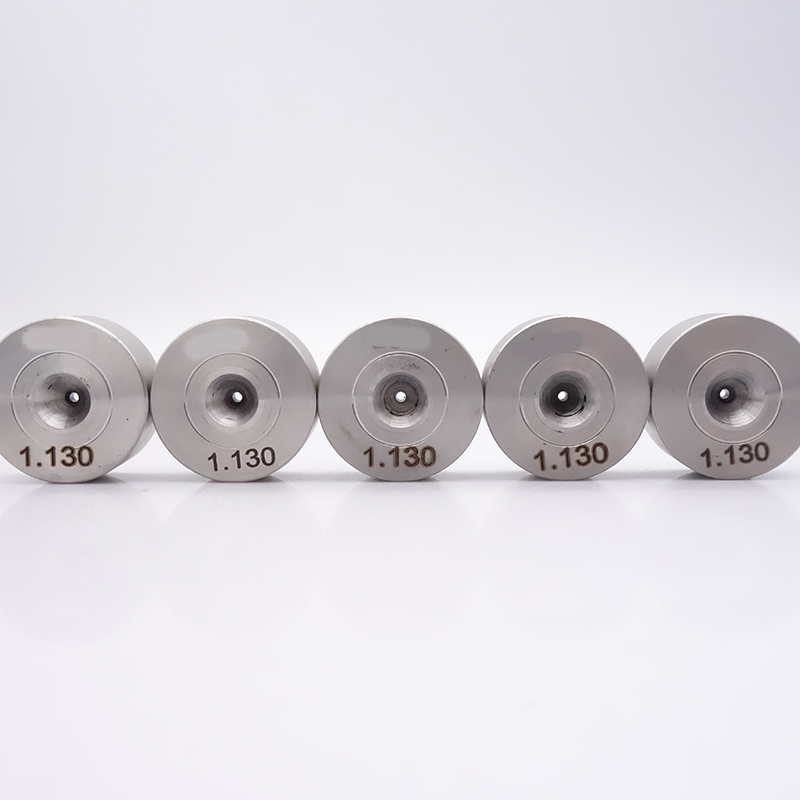Search

ADD:Building 123, Phase 3, Enterprise Base, No. 1 Lianhua Street, High-tech Industrial Development Zone, Zhengzhou, Henan, China
MOB.: +86-15517518512
MOB.: +86-15515520695
E-MAIL: admin@dais.ltd

The appearance of the die ring groove aggravates the wear of the die hole. Because after the ring groove appears in the die hole of the drawing die, the small particles of core material peeled off due to loosening on the ring groove grind the working area and the sizing area like an abrasive. The metal wire entering the die hole, like a die rod, aggravates the wear of the die hole. At this time, the friction between the die hole and the metal wire increases, resulting in high temperature, which intensifies the wear process.
Generally speaking, the wear of the drawing die during the drawing process can be divided into three stages. The first is the sharp point wear stage of the die hole surface, the second is a low and stable rate wear stage, and the third is the high-speed wear stage with the appearance of the wear grooves on the die hole surface.
The influence of drawing conditions on the service life of drawing dies
On the one hand it depends on its quality, on the other hand it also depends on the stretching conditions
(1) Impact of shrinkage rate
In the stretching process, the wire drawing die produces pressure on the metal wire, and the metal wire also produces a back pressure on the wall of the wire drawing die when it is deformed. The greater the reduction rate used during stretching, the stronger the pressure of the hole wall on the metal wire, and the reaction force generated by the metal wire on the hole wall will increase accordingly. If this force is greater than the tensile strength of the mold itself, then The wire drawing die will crack.
(2) The influence of lubricants
In the stretching process, the quality of the lubricant and the sufficient supply of lubricant affect the service life of the drawing die. Lubricants have lubricating, cooling, cleaning and anti-rust effects during the wire drawing process.
(3) The influence of the surface quality of the metal blank
If there is an oxide layer, sand or other impurities on the surface of the metal blank, it will adversely affect the service life of the drawing die. Because the oxide layer on the metal surface is hard and brittle, when the metal blank passes through the die hole, it will cause the die hole of the drawing die to wear quickly and scratch the surface like an abrasive. Therefore, it must be pickled off before stretching; when the blanks are stacked, pay attention to the tidiness of the stacking site and avoid contact with sand and other impurities.
Features of sliding wire drawing machine:
(1) There is sliding between the wire and the winch, so it will be subject to wear, so it is mainly used for drawing copper wire with medium strength.
(2) The tension control is sensitive, the transmission system is simple, and the electrical control requirements are not very strict.
(3) The overall processing rate is large, which is suitable for drawing metal wires with good plasticity.
(4) The drawing speed is high.
(5) It is easy to realize mechanization and automation.
The name and function of each area of the drawing die hole
Inlet area and lubrication area
The entrance area generally has a circular arc, which is convenient to stretch the metal into the work area without being scratched by the edge of the die hole. The lubrication area is to introduce lubricant to lubricate the stretched material.
Work area
The working area is the basic part of metal tensile plastic deformation. Generally speaking, its height is not less than the hole diameter. If it is too small, the stretched metal will exert excessive pressure on the working area of the wire die, which will significantly increase the tensile stress and cause the wire drawing die to wear out too quickly.
The height of the working area varies with the nature of the stretched material, its diameter and lubrication. The principle of its selection is:
1. When stretching the soft metal wire, it should be shorter than the hard metal wire.
2. When drawing a small diameter wire, the larger diameter wire should be short.
3. When stretching with wet lubrication, it should be shorter than dry lubrication.
Selection principle of working cone angle:
1. The smaller the compression rate, the smaller the working cone angle.
2. The harder the stretched wire, the smaller the working cone angle.
3. Stretching small diameter materials with larger diameter materials.
The selection principle of the height of the sizing zone:
1. Stretching soft metal materials is shorter than hard metal materials.
2. Stretching large-diameter materials and shorter-diameter materials.
3. Wet lubrication drawing is shorter than dry lubrication drawing.
The relationship between the stretch half angle of the die hole and the stretch
The stretching force decreases as the stretching half-angle increases, and after reaching a certain value, it gradually increases as the stretching half-angle continues to increase.